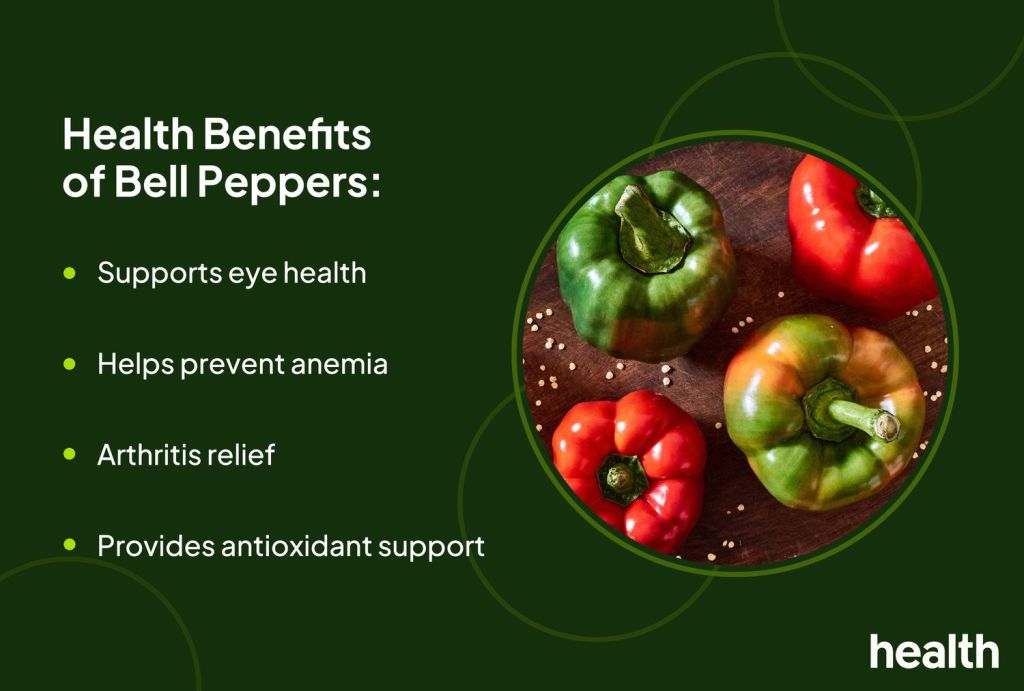
Introduce the subject of peppers, their global popularity in culinary dishes, and the key role they play in nutrition. Emphasize how peppers come in a variety of types—bell peppers, chili peppers, jalapeños, etc.—and how their nutritional profiles can slightly differ depending on the variety. Highlight the importance of understanding their nutritional benefits for a healthy diet.
1. Vitamins and Minerals in Peppers
Peppers are known for being nutrient-dense, especially in vitamins and minerals that support overall health. This section will focus on the primary vitamins and minerals that peppers provide.
- Vitamin C: Peppers, particularly bell peppers, are exceptionally rich in vitamin C. Discuss how this vitamin supports the immune system, aids in the absorption of iron, and acts as a powerful antioxidant. Compare vitamin C content across different pepper varieties, noting that red bell peppers provide more than green ones.
- Vitamin A: Explain the role of vitamin A, which is found in red peppers in the form of beta-carotene. Talk about how this vitamin promotes good vision, skin health, and a robust immune system. Compare this with peppers of other colors and the variations in vitamin A content.
- Other Key Nutrients: Explore the presence of other essential vitamins like vitamin B6, vitamin K1, and folate. These nutrients help in brain function, blood clotting, and overall metabolism.
- Minerals: Highlight the mineral content of peppers, such as potassium, magnesium, and iron. Discuss how potassium helps with muscle function and heart health, while magnesium contributes to bone health and the regulation of blood pressure.
2. The Role of Peppers in Supporting Digestive Health
Peppers, especially hot varieties like chili peppers, are known for containing capsaicin, which can have an impact on digestive health. This section will dive deep into how peppers influence gut health.
- Capsaicin’s Effects: Capsaicin, the compound responsible for the heat in peppers, can aid in digestion by stimulating digestive fluids. Explain how it works to promote gut health, increase metabolism, and even reduce the risk of stomach ulcers by killing bacteria.
- Dietary Fiber: Peppers contain dietary fiber, an essential component for maintaining a healthy digestive system. Explain the role of fiber in promoting regular bowel movements, reducing the risk of constipation, and feeding beneficial gut bacteria.
- Gut Microbiome: Discuss how the fiber and phytonutrients in peppers support a healthy gut microbiome. Elaborate on the relationship between a diverse microbiome and overall digestive health, including its influence on the immune system.
- Spicy Peppers and Gastrointestinal Discomfort: Some people may experience discomfort when eating spicy peppers, such as heartburn or indigestion. Discuss this common concern and provide tips on how individuals can moderate their intake to enjoy the benefits without adverse effects.
3. Antioxidant Properties of Peppers
Peppers are rich in antioxidants, which are compounds that help to neutralize harmful free radicals in the body. This section will cover the various antioxidants found in peppers and how they benefit overall health.
- Vitamin C and E as Antioxidants: While vitamin C is one of the most well-known antioxidants, peppers also contain vitamin E, which protects cells from oxidative damage. Compare these vitamins’ antioxidant properties and how they can slow the aging process and prevent chronic diseases.
- Carotenoids in Peppers: Explain the carotenoid content, especially in red and orange peppers. Carotenoids like beta-carotene, lutein, and zeaxanthin have been shown to improve eye health and reduce the risk of macular degeneration. Discuss their role in reducing inflammation and boosting the immune system.
- Flavonoids and Phenolic Compounds: Peppers also contain flavonoids and other phenolic compounds that have antioxidant properties. Explain how these compounds reduce inflammation and protect against certain cancers and cardiovascular diseases.
- Oxidative Stress and Disease Prevention: Dive deeper into how antioxidants reduce oxidative stress in the body, which can help lower the risk of chronic conditions such as heart disease, cancer, and neurodegenerative diseases like Alzheimer’s. Explore how regular pepper consumption can contribute to long-term health.
4. Peppers for Weight Loss and Metabolism Boosting
This section will focus on the role that peppers can play in weight management and metabolism boosting, particularly through the action of capsaicin and other nutrients.
- Capsaicin’s Thermogenic Effects: Capsaicin has been shown to increase thermogenesis, the process by which the body burns calories to produce heat. Explain how this can contribute to weight loss by boosting metabolism and increasing fat oxidation.
- Appetite Suppression: Research has suggested that capsaicin can help reduce appetite, leading to a lower calorie intake throughout the day. Discuss the potential benefits of including spicy peppers in a weight-loss regimen and how this effect is particularly helpful for people looking to control portion sizes and food cravings.
- Peppers and Caloric Content: Peppers, especially bell peppers, are low in calories and can be consumed in large quantities without contributing to weight gain. Discuss how peppers can be used in low-calorie diets and the benefit of replacing high-calorie ingredients with peppers in meals.
- Supporting Metabolic Health: Beyond weight loss, peppers may also support overall metabolic health. Explore how capsaicin and other compounds in peppers may improve insulin sensitivity, thus helping to regulate blood sugar levels and potentially reducing the risk of type 2 diabetes.
5. The Anti-Inflammatory and Immune-Boosting Effects of Peppers
In this section, explore how peppers contribute to the body’s ability to fight inflammation and boost the immune system, both of which are critical to maintaining good health.
- Capsaicin’s Role in Reducing Inflammation: Capsaicin’s anti-inflammatory properties can help manage conditions like arthritis, psoriasis, and even chronic headaches. Explain how it reduces inflammation by inhibiting the production of certain inflammatory compounds in the body.
- Peppers as Immune Boosters: Vitamin C is crucial for the immune system, and since peppers are one of the richest sources of this vitamin, they play a significant role in boosting immunity. Discuss how regular consumption of peppers can help the body fight off infections, improve skin health, and enhance healing.
- Peppers and Chronic Disease Prevention: Chronic inflammation is linked to many diseases, such as heart disease, cancer, and autoimmune disorders. Discuss how the anti-inflammatory compounds in peppers, including flavonoids and carotenoids, may help reduce the risk of these conditions.
- Phytochemicals and Immunomodulation: Phytochemicals found in peppers, such as capsaicin, can modulate the immune system by improving the body’s natural defense mechanisms. Explain how these compounds support immune cells, particularly during times of stress or illness.
Conclusion
Summarize the key points covered in the article. Reinforce the idea that peppers are not only a versatile ingredient in the kitchen but also an important source of essential nutrients, antioxidants, and anti-inflammatory compounds. Highlight how incorporating peppers into a balanced diet can improve health, support digestion, aid in weight management, and reduce the risk of chronic diseases.




